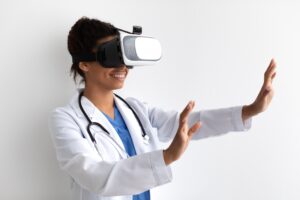A version of this article was previously published in the Journal of mHealth.
While opportunities for continuing education and Pharma-sponsored learning programs are always welcome by healthcare providers (HCPs), it is no secret that traditional HCP education is plagued by a range of issues. Among many others, these include limited participant engagement and retention, suboptimal interaction due to didactic formats, no or low ability to personalize, and the content being too generic or outdated as a result of rapid medical advancements. In addition, HCPs are increasingly demanding flexible learning opportunities. Luckily, recent years have seen a shift in how life science companies educate and train HCPs, with a myriad of novel tools available to help overcome these challenges.
Building on my recent exploration of the top medical education trends of 2024, here, we’re diving into the most anticipated next-generation tools that will take medical education to new levels in 2025.
1. Immersive Mechanism of Action and Pathophysiology Training Tools
 The future of HCP training is immersive. Immersive training tools include everything from virtual and augmented reality to holovision technology—interactive holograms of physicians or patients that guide HCPs through clinical and real-world data, clinical practice scenarios, and patient stories. These technologies can be used to dive deeper into a drug’s mechanism of action or the underlying pathophysiology, gain experience with new devices or techniques, guide treatment decision-making, and practice role-playing or objection-handling for complex clinical situations. While they might not be feasible to have in every clinic or hospital quite yet, these technologies are starting to become more and more common at congresses, conferences, and other large events.
The future of HCP training is immersive. Immersive training tools include everything from virtual and augmented reality to holovision technology—interactive holograms of physicians or patients that guide HCPs through clinical and real-world data, clinical practice scenarios, and patient stories. These technologies can be used to dive deeper into a drug’s mechanism of action or the underlying pathophysiology, gain experience with new devices or techniques, guide treatment decision-making, and practice role-playing or objection-handling for complex clinical situations. While they might not be feasible to have in every clinic or hospital quite yet, these technologies are starting to become more and more common at congresses, conferences, and other large events.
2. Clinical Data Visualization and Interactive Datasets
Other immersive technologies that might be more accessible to a greater number of companies and HCPs include animated leave-behinds for HCPs and patients, such as interactive infographics, posters, and brochures. These are visually-heavy, interactive materials designed to simplify complex concepts and allow HCPs to actively engage with the content. Interactive leave-behinds may include clickable elements, animations, pop-up videos, quizzes, polls, and more, ensuring that learning is engaging and tailored to everyone’s preference, whether they are a “skimmer,” “swimmer,” or “deep-diver.”
In addition to leave-behinds, other educational materials will also become increasingly interactive and immersive in 2025, including treatment/diagnostic guidelines, patient journey maps, and treatment sequence algorithms. Leveraging a microlearning approach (discussed more below), guidelines and treatment algorithms can be broken down into digestible steps and easily accessed on demand, while the incorporation of interactive elements will help the content stand out and improve memory retention.
3. Microlearning Modules
Microlearning has been shown to have a positive effect on the knowledge and confidence of HCPs. Virtual microlearning modules remain a crucial technology for medical education delivery and are the most effective when used in conjunction with other formats. This approach is suitable for education on disease awareness, treatment options and guidelines, and adverse event management. By delivering bite-sized, focused lessons on specific topics, HCPs can engage with the content in manageable segments, anywhere, anytime it fits with their schedule. As a result, they can learn at their own pace, without the need for extended sessions.
Another benefit of this format is the fact that any updates to guidelines or new clinical data can be seamlessly integrated into the relevant micromodules as they become available. As a result, HCPs always have easy access to the latest recommendations without having to attend an entire lecture or retake the whole course for up-to-date information.
Incorporating Case-based and Gamified Learning
 For all of the above technologies, it is recommended to incorporate case-based and/or gamified elements, as these are always appreciated by HCPs, help put new information into clinical context, and can be used to improve real-world skills. When done right, case-based learning ensures that content is relevant and tailored to the participants’ specialty, aligned with guidelines, based on logic, and allows repetition of key points guiding treatment decision-making. If combined with microlearning modules, this might look like progressive case modules, where more and more information is presented as the learner moves through the activity, changing how they might approach diagnosis, treatment, and management. If knowledge checks or quizzes are added throughout, the experience can be further enhanced. Case-based learning can also be incorporated into holovision patient avatars or in the form of interactive patient journey maps, among many other technologies.
For all of the above technologies, it is recommended to incorporate case-based and/or gamified elements, as these are always appreciated by HCPs, help put new information into clinical context, and can be used to improve real-world skills. When done right, case-based learning ensures that content is relevant and tailored to the participants’ specialty, aligned with guidelines, based on logic, and allows repetition of key points guiding treatment decision-making. If combined with microlearning modules, this might look like progressive case modules, where more and more information is presented as the learner moves through the activity, changing how they might approach diagnosis, treatment, and management. If knowledge checks or quizzes are added throughout, the experience can be further enhanced. Case-based learning can also be incorporated into holovision patient avatars or in the form of interactive patient journey maps, among many other technologies.
Likewise, gamified learning—leveraging a combination of points, levels, and/or rewards to encourage participation—can make learning not only fun but also more engaging and motivating. Gamification can easily be incorporated into next-generation educational tools such as microlearning modules, virtual reality, and interactive leave-behinds or guidelines. It can also be used to enhance more traditional learning formats such as webinars and in-person presentations.
The Bottom Line
By leveraging next-generation medical education technologies, life science companies can increase interactivity and engagement while ensuring up-to-date and relevant learning for their HCP target audience. No matter which approach is chosen, the key is to move away from static, didactic presentations and offer something that is personalized and stands out from the crowd. These next-gen tools are already being used by leading pharmaceutical companies in 2025; at the risk of otherwise falling behind, now is the time to make the switch.
About Impetus Digital
Impetus Digital partners with life science organizations to virtualize their in-person meetings and events through our best-in-class InSite Touchpoints™ and InSite Events™ offerings, delivered with white-glove service and 360° coverage and care. Leveraging our large portfolio of cutting-edge online collaboration tools, clients can seamlessly gather insights from, and collaborate with, internal and external stakeholders. To find out more about Impetus Digital, visit our website, follow us on LinkedIn, Twitter, or Facebook, or book a demo at meetwithimpetus.com

